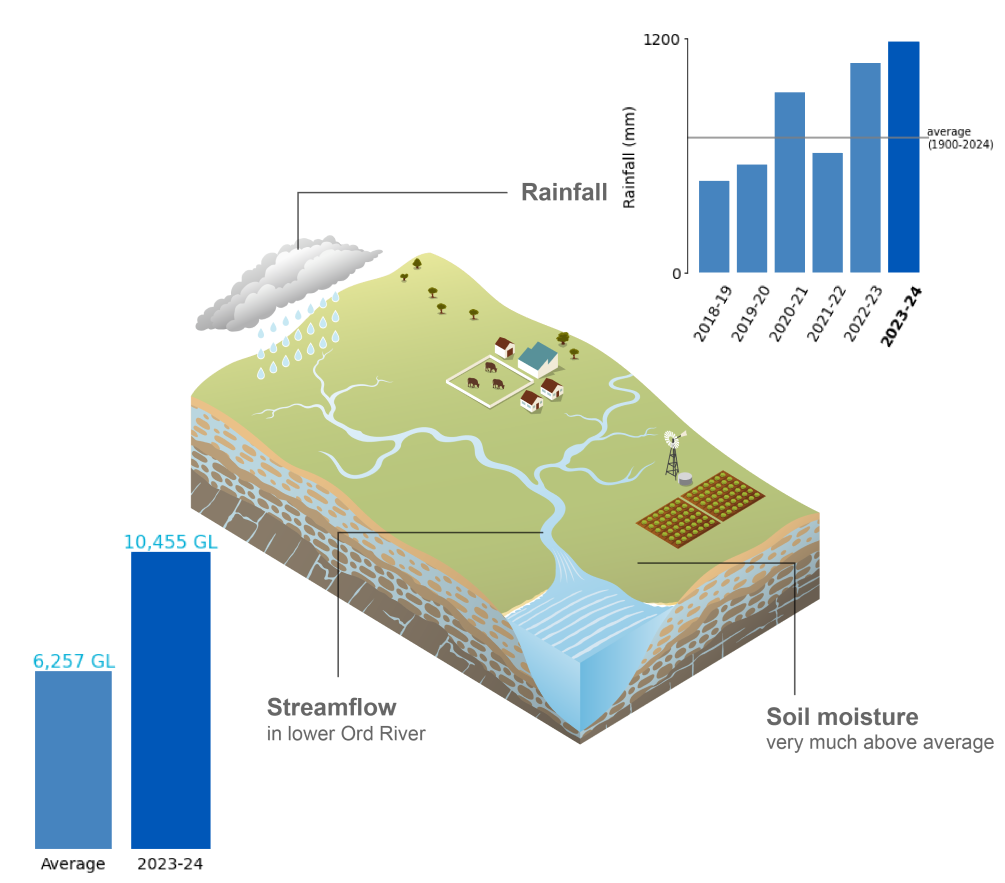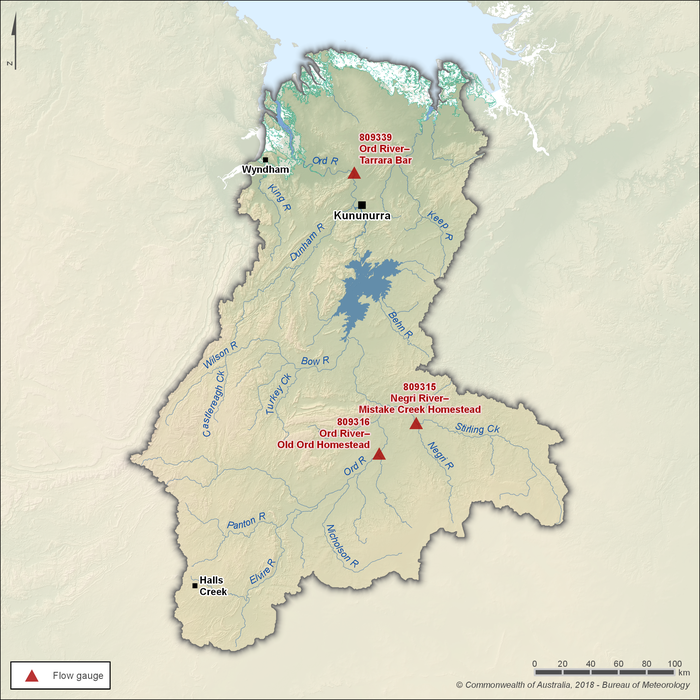Ord: Climate and water
For the water account period 1 July 2023 to 30 June 2024
- Annual rainfall in the Ord region during 2023–24 was the fourth highest on record, with the 2023–24 wet season accounting for 94% of the region's total annual rainfall.
- Soil moisture in the root zone (0–1 m depth) was very much above average across most of the region throughout the reporting period, reflecting the high rainfall that occurred, particularly from January to March.
- Total annual flows in the Ord River, both upstream and downstream of Lake Argyle, were the third highest on record, with streamflows in the Upper Ord River nearly double the long-term annual average.

For further information on the region's climate and water conditions during the 2023–24 year scroll down this page or click on the links below:
About the region
- The Ord region experiences a tropical climate, characterised by hot, humid summers and warm, dry winters.
- Almost all of the region’s rainfall occurs during the northern wet season between October and April.
- Streamflows in the Ord River downstream of Lake Argyle are managed by water releases from Lake Argyle to maintain minimum environmental flows in the lower Ord River. Consequently, flows in the lower Ord River are perennial, while streamflows upstream of Lake Argyle can cease to flow during the dry season between May and September.
Climate conditions
Rainfall
Figure C1 Annual and monthly rainfall deciles for the Ord region during the 2023–24 year
- Total area-averaged rainfall in the Ord region during 2023–24 was 1,185 mm, 72% above the long-term average of 688 mm, making it the region's fourth wettest year, and second-wettest two-year period on record.
- During the first week of July, an unseasonable cloud band produced weekly totals of up to 100 mm in some areas, with many daily and weekly rainfall records were set across the region. This resulted in the region's fourth-wettest July on record.
- After the unseasonable rainfall in June and July, there was little to no rainfall from August to October. While low rainfall is typical for this time of year, it was the second-driest August-to-October period on record for the Ord region.
- In late September, a positive Indian Ocean Dipole (IOD) and an El Niño event in the tropical Pacific Ocean were simultaneously declared underway (as stated in this Climate Driver Update). Historically, concurrent positive IOD and El Niño events have contributed to a delayed northern rainfall onset, which can lead to suppressed rainfall in the early part of the wet season.
- Despite the late start to the northern rains, widespread showers and thunderstorms in late November officially marked the beginning of the 2023–24 wet season. These showers and storms continued in December.
- Over the course of January, an active monsoon trough, and embedded tropical low, produced widespread thunderstorms across the region, resulting in heavy to locally intense rainfall and flooding. This significant rainfall event produced weekly totals exceeding 200 mm to parts of the region, contributing to the region's ninth-wettest January on record.
- A tropical low embedded in the monsoon trough moved across the Top End of the Northern Territory in February, bringing weekly totals up to 200 mm for parts of the region, resulting in February rainfall being 36% above the long-term monthly average.
- Two monsoonal bursts during March further generated showers and thunderstorms across the region, resulting in the region's third-wettest March on record, and second-wettest January-to-March period on record.
- At the end of autumn, the El Niño-Southern Oscillation returned to neutral, with its influence gradually waning on the region's climate, but despite it presence throughout the 2023–24 wet season, it was the fourth-wettest wet season on record, accounting for 94% of the region's total annual rainfall. Much of this rain fell between January and March.
- Following the conclusion of the 2023–24 wet season, rainfall from April to June was close to average.
- More information on the northern wet season and Australia's climate and water during the 2023–24 reporting period can be found in Australia's 2023–24 Northern Wet Season and Financial year climate and water statement 2023–24.
Figure C2 Total monthly rainfall for the Ord region during the 2023–24 year compared with the average and percentiles for the region
- During the 2023–24 wet season, rainfall was above average in November, January, February, and March, with January and March exceeding the 90th percentile.
- Outside of the 2023–24 wet season, rainfall was above the 90th percentile in July.
- Rainfall was equal to or below the 10th percentile from August to October, reflecting the dry conditions leading up to the 2023–24 wet season.
Actual evapotranspiration
Figure C3 Annual and monthly actual evapotranspiration deciles for the Ord region during the 2023–24 year
- Total area-averaged actual evapotranspiration was very much above average across most of the Ord region during 2023–24, reflecting the region's fourth-wettest year on record, enhancing water availability across the region.
- Actual evapotranspiration remained above average across most of the region from July to September, following unseasonably high rainfall in July, which maintained high water availability throughout the dry season.
- With little rainfall from August to October, actual evapotranspiration gradually decreased throughout spring, reaching average to below-average conditions by October.
- In November, widespread showers and thunderstorms increased water availability across the region and contributed to above-average actual evapotranspiration leading into summer.
- Despite the region's ninth-wettest January on record, actual evapotranspiration during January remained average across most of the region, as persistent cloud cover limited evapotranspiration.
- High rainfall throughout summer and into autumn maintained water availability across the region and, with increased sunshine, actual evapotranspiration was above average in February, and remained predominantly above average through to the end of the 2023–24 year.
Soil moisture
Figure C4 Annual and monthly soil moisture deciles for the Ord region during the 2023–24 year
- Soil moisture in the root zone (0–1 m depth) was very much above average across most of the Ord region during 2023–24, reflecting the region's fourth-wettest year on record.
- Following unseasonably high rainfall in July, soil moisture was very much above average across most of the region, with the highest July soil moisture on record observed in parts of the region's south.
- With little rainfall from August to October, soil moisture gradually decreased throughout spring and was predominantly below average by October.
- Widespread rainfall in November caused soil moisture to rebound, becoming average to above average during the final month of spring.
- In response to the region's second-wettest January-to-March period on record, soil moisture increased across much of the region during the second half of summer, with soils becoming heavily saturated in March.
- Despite low rainfall occurring following the conclusion of the 2023–24 wet season, the rainfall from January to March helped maintain predominantly above-average soil moisture conditions through to the end of the reporting period.
- More information on the soil moisture conditions across the Ord region during the 2023–24 reporting year is available on the Australian Water Outlook.
Streamflow responses

Figure C5 Key flow gauging stations along the main rivers within the Ord region
- The Upper Ord and Negri rivers are the two primary river systems that flow into Lake Argyle—one of the largest reservoirs in Australia.
- Three gauging stations are used to represent seasonal flow patterns in the region's rivers, with two situated upstream of Lake Argyle, on the Upper Ord and Negri rivers, while the other gauging station monitors flows downstream of Lake Argyle.
- Flows upstream of Lake Argyle are usually low during the dry season, and can periodically cease to flow. In contrast, flows in the Ord River below Lake Argyle are perennial, regulated by releases of water from Lake Argyle to maintain minimum environmental flows in the lower Ord River, as well as for other purposes such as generating hydroelectricity, diversions for consumptive use, dam operations, and storage overflows.
Figure C6 Total monthly flow for major rivers in the Ord region during the 2023–24 year compared with the average and percentiles
- Total annual flows in the region's major rivers were more than double the long-term averages during 2023–24, following the region's fourth-wettest year on record.
- Streamflows in the Ord River, both upstream and downstream of Lake Argyle, were collectively the third highest on record, with streamflows in the Upper Ord River at Tarrara Bar (Station 809339) nearly double the long-term annual average of 6,256 GL.
- Unseasonable rainfall during the middle of the dry season caused streamflows in both the Negri River at Mistake Creek Homestead (Station 809315) and the Upper Ord River at Tarrara Bar to rise above the 90th percentile in July. Streamflows in the Upper Ord River at Tarrara Bar were the highest on record for July, while streamflow in the Negri River at Mistake Creek Homestead were the second highest on record for July.
- With little rainfall observed from August to October, streamflows dropped to near-base flows downstream of Lake Argyle, while streamflows upstream of Lake Argyle and in the Negri River either dropped to extremely low levels or ceased entirely during spring.
- In response to the region's second-wettest January-to-March on record, streamflows in the Negri River at Mistake Creek Homestead were the highest on record for January.
- Streamflows in both the Negri River and Upper Ord River peaked above the 90th percentile in March, following the region's third-wettest March on record.
- While streamflows in the Lower Ord River are regulated, high rates of overflow from Lake Argyle kept streamflows near the 90th percentile from March to June.
- Following the conclusion of the 2023–24 wet season, streamflows at all sites gradually decreased, returning to near-base flow in the Negri River and Upper Ord River by the end of 2023–24 year, as is typical for these river systems.
Note: streamflows in the Ord River, downstream of Lake Argyle, are regulated by releasing water from Lake Argyle to maintain minimum environmental flows in the lower Ord River. Consequently, flows in the lower Ord River are perennial, unlike streamflows upstream of Lake Argyle, which can cease to flow during the dry season.









